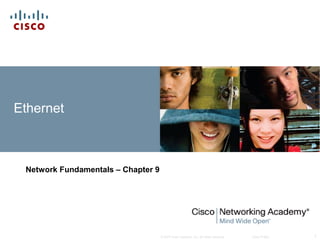Weitere ähnliche Inhalte
Ähnlich wie CCNA Exploration 1 - Chapter 9 (20)
Mehr von Irsandi Hasan (20)
CCNA Exploration 1 - Chapter 9
- 1. © 2007 Cisco Systems, Inc. All rights reserved. Cisco Public 1
Ethernet
Network Fundamentals – Chapter 9
- 2. 2© 2007 Cisco Systems, Inc. All rights reserved. Cisco Public
Objectives
Identify the basic characteristics of network media used in
Ethernet.
Describe the physical and data link features of Ethernet.
Describe the function and characteristics of the media access
control method used by Ethernet protocol.
Explain the importance of Layer 2 addressing used for data
transmission and determine how the different types of
addressing impacts network operation and performance.
Compare and contrast the application and benefits of using
Ethernet switches in a LAN as apposed to using hubs.
Explain the ARP process.
- 3. 3© 2007 Cisco Systems, Inc. All rights reserved. Cisco Public
Characteristics of Network Media used in
Ethernet
Identify several characteristics of Ethernet in its early
years.
- 4. 4© 2007 Cisco Systems, Inc. All rights reserved. Cisco Public
Characteristics of Network Media used in
Ethernet
Describe the emergence of the LAN switch as a key
innovation for managing collisions on Ethernet-based
networks
- 5. 5© 2007 Cisco Systems, Inc. All rights reserved. Cisco Public
Characteristics of Network Media used in
Ethernet
Identify the characteristics of state-of-the-art Ethernet
and describe its utilization of cabling and point-to-point
topography
- 6. 6© 2007 Cisco Systems, Inc. All rights reserved. Cisco Public
Physical and Data Link Features of Ethernet
Standards and Implementation
- 7. 7© 2007 Cisco Systems, Inc. All rights reserved. Cisco Public
Physical and Data Link Features of Ethernet
Describe how the Ethernet operates across two layers
of the OSI model
- 8. 8© 2007 Cisco Systems, Inc. All rights reserved. Cisco Public
Physical and Data Link Features of Ethernet
Logic Link Control – Connecting the Upper Layers
- 9. 9© 2007 Cisco Systems, Inc. All rights reserved. Cisco Public
Physical and Data Link Features of Ethernet
Media Access Control (MAC)
- 10. 10© 2007 Cisco Systems, Inc. All rights reserved. Cisco Public
Physical and Data Link Features of Ethernet
Physical Implementations of the Ethernet
- 11. 11© 2007 Cisco Systems, Inc. All rights reserved. Cisco Public
Function and Characteristics of the Media
Access Control Method
MAC in Ethernet
- 12. 12© 2007 Cisco Systems, Inc. All rights reserved. Cisco Public
Function and Characteristics of the Media
Access Control Method
Carrier Sense Multiple Access with Collision Detection
- 13. 13© 2007 Cisco Systems, Inc. All rights reserved. Cisco Public
Function and Characteristics of the Media
Access Control Method
Ethernet Timing
- 14. 14© 2007 Cisco Systems, Inc. All rights reserved. Cisco Public
Layer 2 addressing and its Impact on Network
Operation and Performance
The Frame – Encapsulating the Packet
- 15. 15© 2007 Cisco Systems, Inc. All rights reserved. Cisco Public
Layer 2 addressing and its Impact on Network
Operation and Performance
The Ethernet MAC Address
- 16. 16© 2007 Cisco Systems, Inc. All rights reserved. Cisco Public
Layer 2 addressing and its Impact on Network
Operation and Performance
Hexadecimal Numbering and Addressing
- 17. 17© 2007 Cisco Systems, Inc. All rights reserved. Cisco Public
Layer 2 addressing and its Impact on Network
Operation and Performance
Another Layer of Addressing
- 18. 18© 2007 Cisco Systems, Inc. All rights reserved. Cisco Public
Layer 2 addressing and its Impact on Network
Operation and Performance
Ethernet Unicast, Multicast and Broadcast
- 19. 19© 2007 Cisco Systems, Inc. All rights reserved. Cisco Public
Compare and Contrast the Use of Ethernet
Switches versus Hubs in a LAN.
Legacy Ethernet – Using Hubs
- 20. 20© 2007 Cisco Systems, Inc. All rights reserved. Cisco Public
Compare and Contrast the Use of Ethernet
Switches versus Hubs in a LAN.
Ethernet – Using Switches
- 21. 21© 2007 Cisco Systems, Inc. All rights reserved. Cisco Public
Compare and Contrast the Use of Ethernet
Switches versus Hubs in a LAN.
Describe how a switch can eliminate collisions, backoffs
and re- transmissions, the leading factors in reduced
throughput on a hub-based Ethernet network
- 22. 22© 2007 Cisco Systems, Inc. All rights reserved. Cisco Public
Explain the Address Resolution Protocol (ARP)
process.
Mapping IP to MAC Addresses
- 23. 23© 2007 Cisco Systems, Inc. All rights reserved. Cisco Public
Explain the Address Resolution Protocol (ARP)
process.
ARP – Destinations Outside the Local Network
- 24. 24© 2007 Cisco Systems, Inc. All rights reserved. Cisco Public
Explain the Address Resolution Protocol (ARP)
process.
ARP – Removing Address Mappings
- 25. 25© 2007 Cisco Systems, Inc. All rights reserved. Cisco Public
Explain the Address Resolution Protocol (ARP)
process.
ARP Broadcasts - Issues
- 26. 26© 2007 Cisco Systems, Inc. All rights reserved. Cisco Public
Summary

